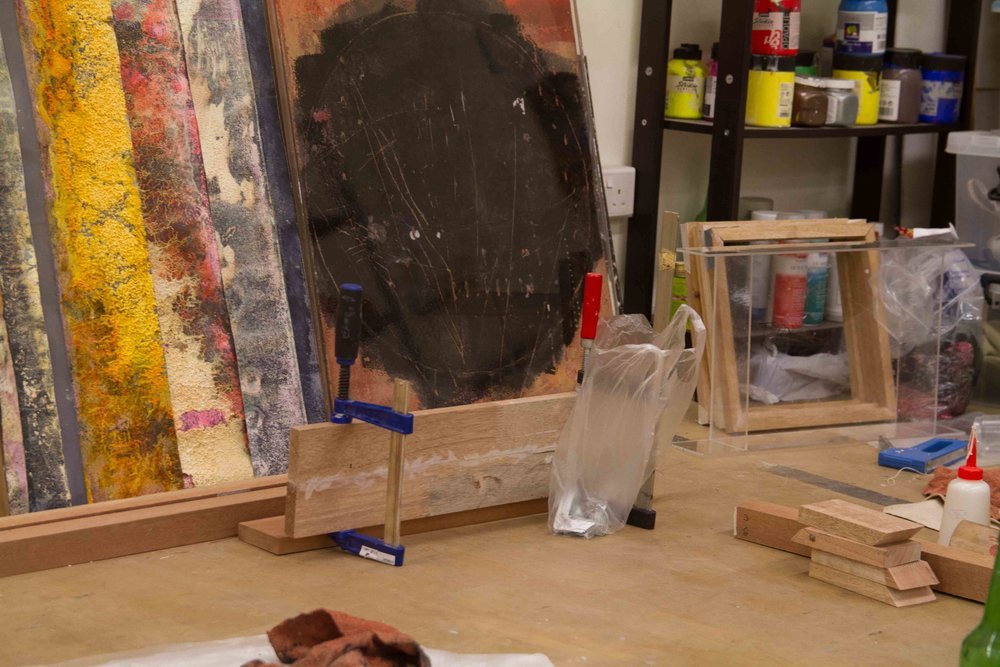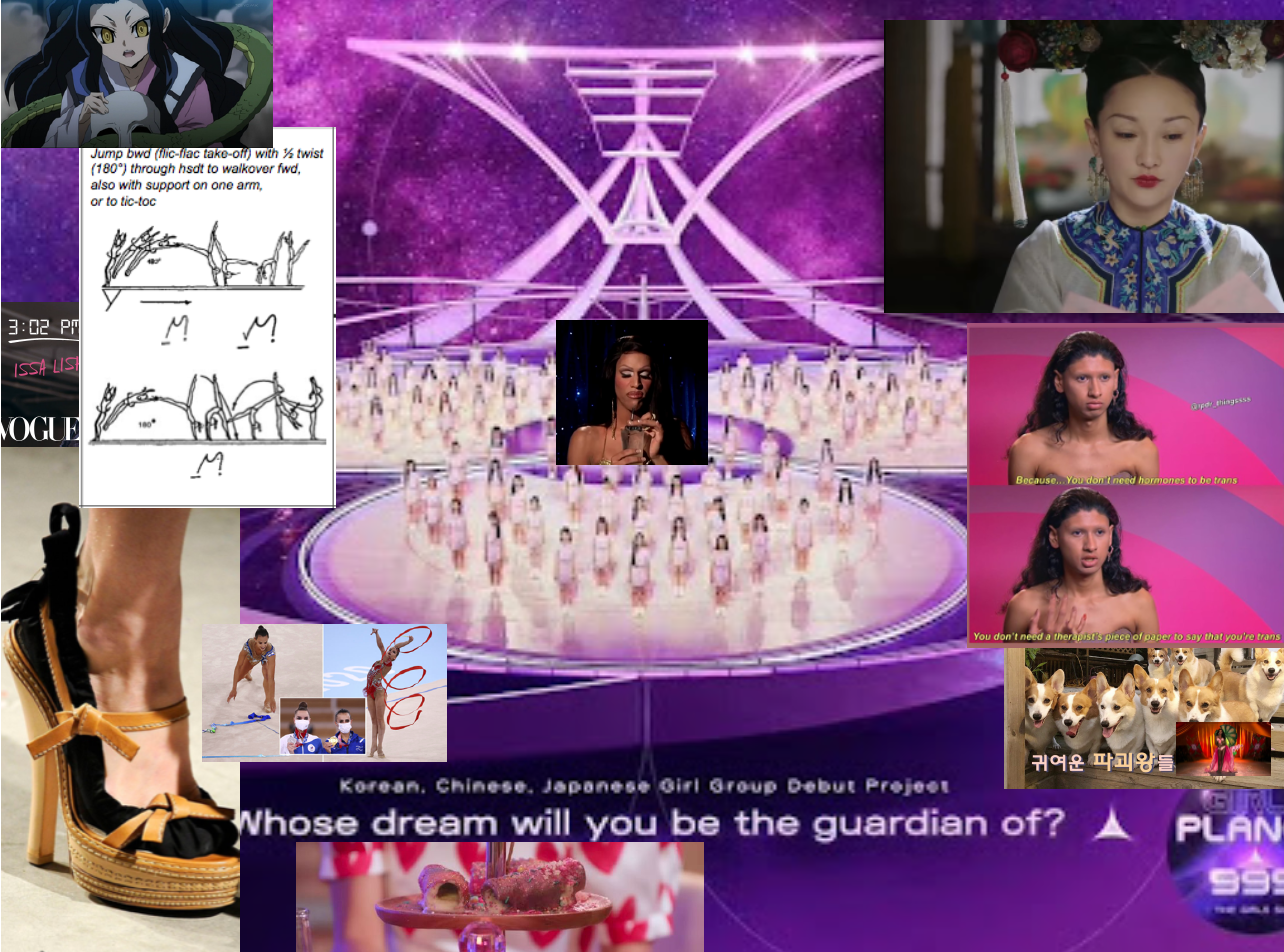Conversation with Jay Ho
On taking chances and friendships
By Ian Tee
Jay Ho, 'Mourn', 2017, acrylic foam print and resin on paper and canvas, 100 x 80cm. Image courtesy of the artist.
Jay Ho (b. 1997) is a young Singaporean painter working with the elements of process and chance. Since graduating from the Nanyang Academy of Fine Arts (NAFA) in 2017, his works have been featured in group exhibitions such as 'Talking Textiles #2' at One East Asia Gallery, 'The Dung Beetle Project' at Chan + Hori Contemporary, as well as 'New Now 2' and 'Conversations on Lack and Excess' at Gajah Gallery Singapore and Jogjakarta.
In this interview, we speak with Jay about the processes behind his work, the role of peer support in a young artist's career and what we can expect for his debut solo exhibition.
A close-up view of the dried resin surface. Image courtesy of the artist.
We first met at your graduation show in 2017 where you presented the 'Strain' series. Those paintings were made with resin hardeners but evoke organic forms that resemble bacterial growth or fungus. What is the process behind producing these works and what do you enjoy about them?
I came across this material property when I left mixing cups unattended for a week while casting objects. Depending on the medium underneath, it takes between five days to two months for the resin to set. Most of the paintings in this series were made on older works and earlier foam printed surfaces. The resin reacts with pigment from old paint on reused canvases while newspaper ink creates unpredictable patches of colours and tinting. The underlying resin layers continue to set in the coming months, and the surface is still subjected to changes depending on how the painting is hung and its surroundings.
This meant that the outcome of these works was largely unpredictable, and that requires me to remove expectations I have towards any outcome. It is also what I enjoy most about this way of working. It offers surprising ways to revive old works, to readjust my eyes and to discover different perceptions from the audience. I have also learnt to accept the outcome regardless of my effort and expectations. If it does not work out I can always start afresh with a new piece.
I’ve always been interested in the sense of the cosmic, scale, and limits of human perception. I found that the different definitions of “Strain” seem to relate to the process and concept of this series. "Strain" can refer to a collective noun for ancestry or species, but also a verb to describe the great effort against resistance or to pull a muscle. The word also connects to the way materials behave in these works: a flowing medium splitting into branches or the exertion caused by resin as it sets on the canvas fibres.
What audiences see from in these paintings range from topographies of cities and rivers branching out, to rotting flesh, cancer cells and rust. Everyone needs an encounter with the sublime in one way or another, and I am searching for it through painting.
Jay Ho, 'Orion III, II and I' (from left), 2018, resin and gloss paint on canvas panel, dimensions variable. Image courtesy of the artist.
Recently you were part of a few group exhibitions such as the 'Dung Beetle Project' at Chan + Hori Contemporary (CHC) as well as two group shows at Gajah Gallery. How did the opportunities come about?
'Dung Beetle Project' was initiated by my peers and I as part of our graduation show theme. It was a playful take on art-making as a Sisyphean action, a pessimism that only a minority of us would continue practising art down the road in spite of trying. To the beetle, the dung is a source of food and shelter but to the outside world, the dung has no practical value. As artists, we questioned: why do we spend so much effort practising something that is of no practical value?
We first met Khai Hori (Curatorial Director of CHC) during an artist talk at school and he was also a guest critic during our final year projects. He approached us when we attended their inaugural exhibition at Gillman Barracks and offered us a show. Prior to that, we had submitted another proposal but it was not accepted.
Similarly, we spoke to Jasdeep Sandhu (Director of Gajah Gallery) at Erizal's exhibition opening and he was kind enough to ask us to send a proposal or a list of artists. Some of us eventually exhibited in the 'New Now' series that showcases emerging artists. I participated in its second edition. 'Conversations on Lack and Excess' which was a group exhibition at Gajah's Jogjakarta space curated by Liza Markus, a peer who was part of the Dung Beetle Project too. That show brought together works by artists from Singapore and different parts of Indonesia.
'The Dung Beetle Project', 2017, installation view of Jay Ho's works. Image courtesy of Chan + Hori Contemporary.
What can we expect in your upcoming solo exhibition at Chan + Hori Contemporary (CHC) which opens in March 2019?
For this show, I’ll be exhibiting a few different approaches in my practice such as the resin casts, etching on foam boards, and prints. This includes revisiting print techniques which involve the use of old foam panels commonly found on posters. I will also explore possibilities in exhibiting both the print and etched panel as two separate works.
Instead of viewing them as a continuous series, I prefer seeing the different works as parallels. I also wanted to reduce dependence on a single medium. Due to the unpredictable nature of my processes, I always produce an excess of works and narrow down a selection for the exhibition. Those that don’t make the cut will be reused for future paintings.
Jay Ho, 'Enceladus', 2017, acrylic foam print and resin on wood, 60cm (diameter). Image courtesy of the the artist.
How has it been serving full-time National Service while continuing to practise?
It has been quite a crazy journey. I would never have thought that I would be involved in these shows when I enlisted 16 months ago. At that time, my lecturer told me that many seniors stopped practising after their service and that it is difficult to catch up if one is inactive. Thus I promised myself to keep the momentum going whether I am producing work or visiting shows. This is made easier by keeping in touch with peers who are practising as we share opportunities and keep the dialogue going.
My paintings require a lot of waiting time so staying in camp on weekdays and booking out on the weekends happens to fit my workflow. Of course, I still prefer staying out! The five days spent in camp also act as a breathing space between the short spurts of studio time. I use this period to think about the next steps to execute and how I can maximise my free time. When the weekends come, I’m always excited to see the outcome on the paintings with a fresh pair of eyes.
What is one piece of advice that you were given which remains important?
My mentor Raymond Yap told me: Art is about Dreams, Debates and Friendships. This has stuck with me and there's something about it that keeps me going. I’ve never actually thought further about it but I find the idealism uplifting.
A view from Jay's current studio. Image courtesy of the artist.
Can you speak to the role of peer support in carrying you forward after graduation?
My friends and I came together in school when we felt that it was somewhat of a cocoon. It was also the same time that we recognised the importance of looking at art and events happening outside of the institution, and to create outside of the curriculum bubble. Attending exhibitions and events together broadened our horizon about the art scene and encouraged us to take the first steps in proposing exhibitions. A few of them have been realised such as the group exhibitions at CHC and Gajah mentioned earlier. The most recent show my peers organised was 'Orthodox' presented during Singapore Art Week 2019, at Your Mother Gallery and Coda Culture.
It is very expensive and challenging to practise once one is out of the studio environment in school, especially when most of us have full-time jobs and have to pay rent. As such, peer support is one of the most important aspects of maintaining an art practice. We share open calls and job opportunities among ourselves, and turn to each other for help with logistics, set up, and production. I have to thank my studio mate Jaxton Su for sharing his space or I would still be making art in my tiny room! My gratitude also goes to Bryan Tan for his unending help whenever I am unavailable in camp, as well as friends like Gabriel Loy, Warren Khong, Lau Eng Seng (and of course you, Ian) who have been encouraging me throughout my time in National Service.
What are your plans for the future?
Moving forward, I’m keen to explore the art scene in Thailand and particularly, Chiang Mai. My mother is born in Phayao, a small city beside Chiang Mai, so I’ve been travelling between Thailand and Singapore from a young age. The experience has definitely influenced my worldview. I guess it’s my way of exploring my roots and to give back to my family. This also pushes me out of my comfort zone so I’m excited to see how my practice develops in this new environment. I have never identified strongly with my race or location, but National Service has prompted me to think more about what it means to be a Singaporean.
Later this year, I will be in Shanghai for a residency with Liza where we hope to explore our Chinese identities.
Jay’s debut solo exhibition ‘Catalyst’ opens at Chan + Hori Contemporary on 2 March 2019, from 5pm to 8pm. The show will be on view till 20 March 2019.



















